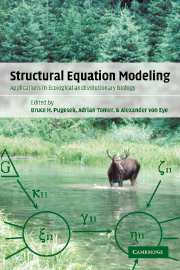Book contents
- Frontmatter
- Contents
- List of contributors
- Preface
- Section 1 Theory
- 1 Structural equation modeling: an introduction
- 2 Concepts of structural equation modeling in biological research
- 3 Modeling a complex conceptual theory of population change in the Shiras moose: history and recasting as a structural equation model
- 4 A short history of structural equation models
- 5 Guidelines for the implementation and publication of structural equation models
- Section 2 Applications
- Section 3 Computing
- Index
4 - A short history of structural equation models
Published online by Cambridge University Press: 14 October 2009
- Frontmatter
- Contents
- List of contributors
- Preface
- Section 1 Theory
- 1 Structural equation modeling: an introduction
- 2 Concepts of structural equation modeling in biological research
- 3 Modeling a complex conceptual theory of population change in the Shiras moose: history and recasting as a structural equation model
- 4 A short history of structural equation models
- 5 Guidelines for the implementation and publication of structural equation models
- Section 2 Applications
- Section 3 Computing
- Index
Summary
Abstract
The goal of this chapter is to provide a historical account of structural equation modeling (SEM). To do so I followed the development throughout the twentieth century of the main ideas in the four disciplines that contributed to the development of SEM: biometrics, econometrics, psychometrics, and sociometrics. Special attention is paid to the development of path analysis by Wright and its sociological applications. Also presented are the development of estimation procedures and the formulation of identification issues in econometrics and the beginning of exploratory and confirmatory factor analysis in psychology. The last part of this account presents the synthesis of these ideas in the LISREL model as well as extensions of the original model.
- Type
- Chapter
- Information
- Structural Equation ModelingApplications in Ecological and Evolutionary Biology, pp. 85 - 124Publisher: Cambridge University PressPrint publication year: 2003
- 13
- Cited by

